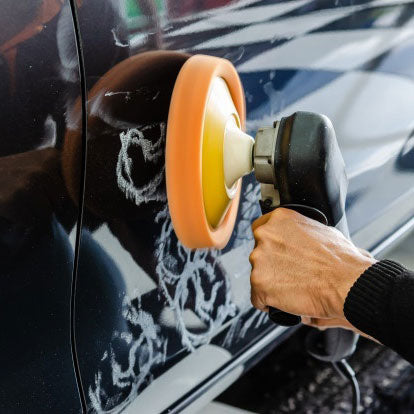When the winter comes it brings with it a unique set of challenges for vehicle owners. From icy roads to freezing temperatures and moisture build up, your car faces more than just a drop in temperature, it endures conditions that can cause extensive damage if not properly addressed.
Winterizing your vehicle is not just about swapping tires or checking antifreeze levels; it’s also about giving your car the detailed protection it needs to weather the storm.
Let us discuss how proper winterization detailing can protect your vehicle’s paint, undercarriage, and interior, and offer step-by-step tips to prepare your car for the colder months ahead.
Why Winterization Detailing Matters
Detailing for winter goes beyond the vehicles aesthetic, it’s about preservation and prevention. Harsh winter elements such as road salt, snow, slush, and fluctuating temperatures can corrode metal, stain upholstery, damage paint, and degrade the performance and appearance of your vehicle over time.
Key Benefits of Winterization Detailing:
- Prevents rust and corrosion on undercarriage and paintwork.
- Protects interior surfaces from moisture, grime, and temperature extremes.
- Improves visibility and safety through clean windows and headlights.
- Enhances resale value by maintaining your vehicle’s condition.
- Extends lifespan of various vehicle components.
Exterior Detailing

The Threat:
Salt and grime are the biggest enemies for your car’s exterior during winter. Salt accelerates rust formation, while sand and grit can scratch the paint. Combined with moisture, these elements can severely degrade your vehicle’s outer shell.
Step-by-Step Exterior Preparation:
1. Thorough Wash
- Use a pH-balanced car shampoo to remove dirt and contaminants.
- Pay close attention to wheel wells, lower doors, and the front grille where salt tends to accumulate.
- Use a two-bucket method (one for soapy water, one for rinsing) to prevent reapplying dirt to the surface.
2. Decontamination
- Use a clay bar to remove embedded contaminants that washing alone can’t lift.
- Follow with a surface prep spray to ensure a clean base for protection layers.
3. Paint Protection
- Apply a high-quality paint sealant or ceramic coating. These provide a durable shield that repels water, dirt, and contaminants.
- For shorter-term protection, a synthetic wax will suffice, though reapplication during winter may be necessary.
4. Protective Film (Optional)
- Consider installing paint protection film (PPF) on vulnerable areas like the front bumper, hood edge, and side mirrors to defend against rock chips and salt spray.
Undercarriage Cleaning and Protection

The Threat:
Your undercarriage takes a beating from road salt, snow, and ice. Rust often begins here and spreads, compromising structural components, brake lines, and suspension parts.
Undercarriage Detailing Steps:
1. High-Pressure Rinse
- Use a pressure washer or drive-through car wash with an undercarriage cleaning feature to blast away salt and debris.
2. Degreasing
- Apply an automotive degreaser to remove built-up grime and oil that attract and hold salt particles.
3. Rust Inhibitor or Undercoating
- Apply a rust inhibitor or rubberized undercoating spray to create a barrier against moisture and salt.
- Focus on high-risk areas such as wheel wells, axles, and exhaust pipes.
4. Inspect and Reapply
- Periodically inspect the undercarriage throughout winter and touch up areas where the coating may have worn away.
Wheels and Tires

The Threat:
Wheels and tires face constant contact with salt and grit, leading to corrosion and decreased traction.
Detailing Tips:
1. Wheel Cleaning
- Use a dedicated wheel cleaner that is safe for your wheel finish (chrome, aluminium, etc.).
- Use a wheel brush to get into crevices and remove brake dust and salt.
2. Wheel Sealant
- Apply a wheel sealant or ceramic coating to prevent contaminants from sticking and to make future cleaning easier.
3. Tire Dressing
- Use a water-based tire dressing to protect rubber from cracking due to freezing temperatures and UV exposure.
4. Tire Check
- Ensure winter tires are installed and properly inflated. Cold weather causes air pressure to drop, affecting handling and wear.
Glass and Headlights

The Threat:
Fog, ice, snow, and grime reduce visibility, posing a safety risk.
Key Steps:
1. Window Cleaning
- Clean windows inside and out with a streak-free glass cleaner.
- Apply a rain-repellent treatment to exterior glass to improve visibility during rain and snow.
2. Headlight Restoration
- If headlights are foggy, use a restoration kit to clear the lenses.
- Apply a UV sealant to prevent re-clouding.
3. Wiper Maintenance
- Replace old wiper blades with winter-rated versions.
- Top up with a winter washer fluid that resists freezing.
Interior Detailing

The Threat:
Moisture from wet shoes, road salt, and temperature changes can ruin upholstery, cause mould, and degrade interior materials.
Interior Preparation Steps:
1. Deep Clean
- Vacuum carpets and upholstery thoroughly.
- Use a carpet extractor or steam cleaner if necessary to remove embedded dirt and salt residue.
2. All-Weather Floor Mats
- Replace fabric mats with rubber or vinyl mats that trap moisture and are easy to clean.
- Use mats with raised edges to contain meltwater and debris, if necessary.
3. Upholstery Protection
- Apply fabric guard to cloth seats to resist staining.
- Use a leather conditioner on leather seats to prevent cracking due to dryness.
4. Interior Surface Treatment
- Clean dashboards, centre consoles, and doors with a mild interior cleaner.
- Use a UV protectant to prevent fading and cracking.
Car Boot/Trunk and Emergency Supplies

Don’t forget to detail and prepare your trunk considering it’s where essentials often get stored.
Trunk Area Tips:
- Vacuum and wipe down the area.
- Line the trunk with a rubber trunk liner.
- Stock a winter emergency kit, including:
- Ice scraper and snow brush
- Jumper cables
- Blanket and gloves
- Flashlight
- Road salt or kitty litter (for traction)
- First aid kit
Routine Maintenance Checks

While not strictly “detailing,” regular maintenance supports your detailing efforts and ensures your vehicle performs reliably in winter.
Winter Maintenance Checklist:
- Check battery condition—cold weather reduces battery efficiency.
- Inspect brake pads and rotors.
- Ensure all fluids (oil, antifreeze, brake fluid) are at proper levels.
- Keep fuel tank at least half full to prevent freezing moisture in fuel lines.
Professional vs. DIY Detailing for Winter?

DIY:
- More cost-effective
- Flexible scheduling
- Allows personal inspection
Professional:
- Access to advanced tools and products
- Superior protection options (e.g., ceramic coatings)
- Time-saving
If you lack time or expertise, a professional winterization detail package can provide long-lasting protection and peace of mind.
So what have we learnt? Prepare Early, Protect Thoroughly
Winter can be tough on vehicles, but with the right detailing techniques, you can protect your investment from the elements. Preparing your car for winter through exterior, undercarriage, and interior detailing ensures that your vehicle stays in top shape, performs reliably, and retains its value.
Take the time to winterize your vehicle before the first cold breaks through, it’s a proactive step that pays off in durability, appearance, and safety.
- Jaz Anna
Want to learn more about Auto Detailing?
Why not take a look at one of our courses below:
EZEAD001 Auto Detailing
EZEGWT001 Glass Window Tinting
or check out Richard Anthony's book: CAR FLIPPING MASTERY




